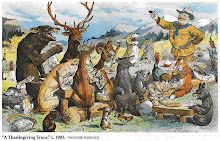Changes in Presettlement Forest Composition for Five Areas in the Central Hardwood Forest, 1784-1990
James S. Rentch1 Ray R. Hicks, Jr.2 Division of Forestry West Virginia University P. O. Box 6125 Morgantown, WV 26506; 2005
Study Area: Eastern Ohio, south western Pennsylvania and
north-central West Virginia

ABSTRACT: Witness tree tallies from early land surveys show that presettlement forests in eastern Ohio, southwestern Pennsylvania, and north central West Virginia were oak-dominated forests. Quercus alba(White Oak) was dominant by a large margin – at minimum, twice as abundant as Q. velutina(Black Oak), the second ranked species. Acer saccharum(sugar Maple) and Fagus grandifolia(American Beech) were among the top ten ranked species at each site; however, their importance value was consistently less than one-third the value for Q. alba.
White Oak leaves are round-lobed(not cut like red oak)
Quercus rubra(red oak), Q. prinus(chestnut oak), Castanea dentata(American Chestnut), and A. rubrum(red maple) were relatively minor components of presettlement forests, rarely ranked among the 10 most abundant tree species. Where diameter-distribution data were available, results show that oaks were well distributed among all but the smallest size classes, suggesting that oak replacement was a stable feature of these forests.
The majestic White Oak
Multiple response permutation procedure analysis of pre-settlement and modern U.S. Forest Service Forest Inventory analysis (FIA) data shows a clear separation by historical period. Modern inventories consistently show a significant decline in Q. alba abundance and a large increase for A. rubrum. Other early successional species such as Prunus serotina(black cherry), Liriodendron tulipifera(tulip tree), and Fraxinus americana(American Ash) showed large increases, although this trend varied somewhat among the sites studied.
The red maple leaf(and forest below)
The species composition of presettlement forests suggests a highly variable disturbance regime in which a variety of species with different life history strategies, disturbance tolerances, and growth requirements shared overstory position. Changes in species dominance over the time period reviewed suggest that 20th century reduction in fire frequency resulted in reduced oak abundance and accelerated recruitment of fire intolerant species.














No comments:
Post a Comment